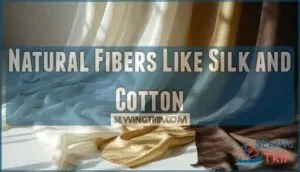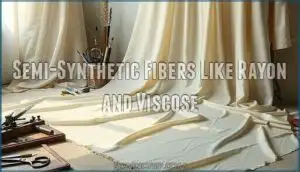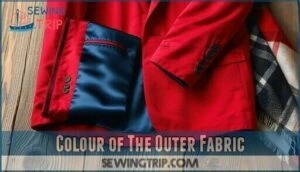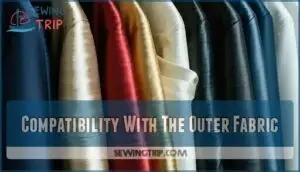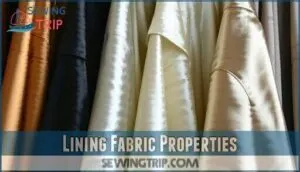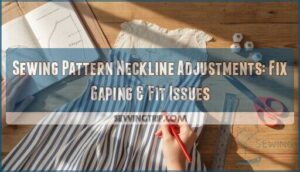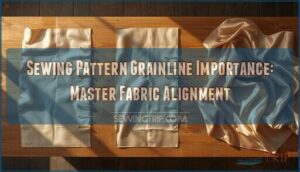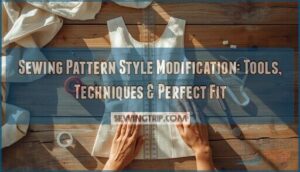This site is supported by our readers. We may earn a commission, at no cost to you, if you purchase through links.

Silk adds a luxurious feel but can be pricey, while cotton is breathable and great for casual wear. Polyester and acetate are budget-friendly, wrinkle-resistant options, though they’re less breathable.
Rayon and viscose strike a nice balance, offering smoothness without breaking the bank. Match the lining to your jacket’s purpose—lightweight for summer, insulated for winter—and verify it complements the outer fabric.
Think of it as the unsung hero of your jacket: it’s not flashy, but it keeps everything running smoothly. Ready to explore custom lining ideas to enhance your jacket’s overall durability?
Table Of Contents
Key Takeaways
- Match the lining fabric to your jacket’s purpose—silk for luxury, cotton for breathability, or polyester for durability.
- Choose breathable and moisture-wicking materials like rayon or viscose for comfort in different climates.
- Opt for durable, wrinkle-resistant fabrics like polyester or acetate to keep your jacket looking sharp.
- Customize linings with bold patterns or unique designs to add personality and style to your jacket.
Jacket Lining Basics
Jacket linings aren’t just about looks—they play a key role in comfort, durability, and fit.
A jacket lining is the hidden hero, blending comfort, durability, and style to elevate your wardrobe effortlessly.
Understanding their history and purpose helps you choose the right fabric for both function and style.
History of Jacket Linings
Jacket linings had purposeful beginnings, crafted to shield garments from sweat and oils.
Early lining materials, like cotton or silk, added comfort and warmth.
Over time, they gained social significance, evolving into decorative elements that reflected personal style.
Today’s modern revivals honor this fashion history, blending practicality and flair, proving that lining fabric types are more than just hidden details, with a focus on practicality.
Evolution of Linings
Over time, linings transformed from purely functional to stylish essentials. This Lining Functionality Shift highlights their role in modern fashion.
The Decorative Lining Rise brought bold patterns and colors, while the Material Innovation Timeline introduced advanced jacket lining fabric. Linings now reflect cultural trends and personal expression, showcasing:
Linings also enhance a jacket’s structure, weight, and shape, improving its overall appearance, as detailed in this guide to jacket linings.
- Enhanced jacket durability
- Improved lining fabric properties
- Evolving lining material choices
- Linings’ Social Impact on style
Practical Benefits of Linings
A good jacket lining fabric isn’t just about looks—it’s your secret weapon for comfort improvement and crease reduction.
Acting as a protective barrier against sweat, it also boosts durability, extending your jacket’s life.
Plus, a breathable lining keeps you cool, while durable lining material guarantees shape retention.
It’s like giving your jacket a reliable, hardworking best friend.
Selecting the right lining, like breathable Bemberg options, further enhances the garment’s overall quality with a reliable choice.
Lining Fabric Types
In the context of jacket linings, you’ve got plenty of options, from natural fibers like silk and cotton to synthetic choices like polyester and acetate.
Each type offers unique benefits, balancing comfort, durability, and style to suit your needs.
Natural Fibers Like Silk and Cotton
Silk and cotton are standout choices for jacket lining fabric, offering natural comfort and practical benefits.
Silk lining provides unmatched breathability, perfect for a polished, breathable lining. Cotton durability shines in everyday wear, with weave variations adding versatility.
Both fibers excel in fiber sourcing, ensuring quality. Consider silk lining options for a luxurious feel.
Whether it’s silk’s elegance or cotton’s resilience, these natural materials elevate any jacket effortlessly.
Synthetic Fibers Like Polyester and Acetate
Polyester lining is a champ for durability, resisting wrinkles and stains like a pro.
Acetate lining, on the other hand, shines with breathability and fights static buildup, keeping you comfy.
Both synthetic materials offer cost-effective options, with blending options enhancing versatility.
Consider comparing material options before deciding. If you’re after a practical, smooth lining fabric, these synthetic choices balance affordability and performance beautifully.
Semi-Synthetic Fibers Like Rayon and Viscose
Rayon lining and viscose lining are semi-synthetic favorites for their softness and versatility.
With viscose breathability and rayon durability, they’re perfect for both lightweight and heavier fabrics.
Bemberg lining, a premium option, adds anti-static comfort.
While rayon production is intensive, viscose blends offer balance.
Viscose is a common type of rayon.
A sewn lining with these fabrics guarantees smoothness, making jackets stylish and practical.
Choosing Lining Fabric
When choosing lining fabric, you’ll want to think about how it complements the jacket’s outer material and purpose.
A well-matched lining boosts comfort and also guarantees your jacket looks sharp and lasts longer.
Colour of The Outer Fabric
Matching your jacket lining color with the outer fabric creates Neutral Harmony, while Contrasting Linings add flair.
For Patterned Outerwear, pick a subtle lining fabric to avoid clashing.
Bold Combinations, like red with navy, can make your jacket pop.
Complementary Colors, such as beige with brown, keep things cohesive.
Explore fabric options to balance style and function seamlessly.
Purpose of The Clothing
When choosing jacket lining, think about its purpose. Does it suit the climate or the occasion?
For example:
- Warmth: Wool jackets need insulating linings for winter.
- Breathability: Cotton or rayon works for humid climates.
- Formality: Silk linings elevate formal wear.
- Durability: Polyester suits daily use.
- Personal Expression: Bold patterns add flair for creative events.
Match lining fabric to function! Consider fabric weight considerations for the lining to guarantee it complements the outer fabric.
Compatibility With The Outer Fabric
A good jacket lining complements the outer fabric in weight, texture, and drape harmony.
Pick a lining material that matches the care requirements of the outer fabric—nobody wants a dry-clean-only disaster.
Watch for color bleeding and make certain the lining fabric doesn’t overpower the jacket’s look.
Balanced compatibility keeps your jacket stylish, durable, and easy to maintain, ensuring a stylish appearance.
Lining Fabric Properties
When picking lining fabric for a jacket, you’ll want something that’s breathable, durable, and smooth against your skin.
These properties both boost comfort and keep your jacket looking sharp and lasting longer.
Breathability and Moisture-Wicking
Breathable, moisture-wicking jacket linings can make or break your comfort.
The right lining material guarantees fabric ventilation and sweat absorption, keeping you cool and dry.
Consider these options:
- Cotton or rayon: Perfect for warm climates and active days.
- Silk or viscose: Lightweight and luxurious, ideal for layering impact.
- Polyester lining: Budget-friendly, though less breathable.
Stay comfortable, whatever the climate or activity level!
For enhanced dryness, consider options that utilize capillary action effectively.
Durability and Wrinkle Resistance
Durability and wrinkle resistance are key for a lining fabric that lasts.
Polyester lining and acetate lining stand out with strong fiber strength and abrasion resistance, ensuring a longer fabric lifespan.
A dense weave enhances durability, while crease recovery keeps jackets looking sharp.
Whether tackling daily wear or occasional use, these properties mean less fuss and more polished style.
Smoothness and Softness
A smooth lining can make or break your jacket’s comfort.
It’s all about the fabric handfeel and sensory experience. Look for materials that reduce friction and enhance layering ease.
Here are five great options:
- Silk lining: Luxurious and soft.
- Bemberg lining: Anti-static and breathable.
- Acetate lining: Lightweight and smooth.
- Rayon blends: Silky yet durable.
- Polyester satin: Affordable and sleek.
Customizing Jacket Linings
Customizing your jacket lining lets you add a personal touch that’s both stylish and functional.
Whether it’s a bold pattern or a subtle monogram, these details can turn an ordinary jacket into something uniquely yours.
Bespoke Linings and Unique Designs
Custom jacket linings let you turn a simple jacket into a canvas for artistic expression.
Turn your jacket into a masterpiece with custom linings that showcase bold patterns, unique designs, and personal flair.
With custom lining options, you can showcase unique creations like bold patterns, custom artwork, or even a favorite quote.
These customization trends make every jacket lining personal and memorable, blending style with individuality.
It’s where lining material meets creativity, redefining your wardrobe.
Personalization Options and Trends
For a touch of flair, explore custom lining art or initial embroidery to personalize your jacket.
Patterned lining trends, like paisley or bold geometrics, add personality, while custom fabric choices let you pick textures and prints that resonate.
Unique color pops, subtle or striking, elevate your style, and personalized linings combine function and creativity, making your jacket uniquely yours, with a touch of custom flair.
Enhancing Jacket Uniqueness and Style
Making your jacket stand out is easier with custom lining. Artistic linings and custom patterns let you express personality subtly yet stylishly.
Consider these ideas:
- Add Custom Initials: Embroider your initials for a polished, personal touch.
- Choose Unique Fabrics: Opt for bold colors or luxurious textures.
- Incorporate Lining Personalization: Select lining material featuring meaningful designs or themes.
To enhance the coat’s functionality, consider fabric weight considerations.
Frequently Asked Questions (FAQs)
What fabric to use for lining a jacket?
Choose silk for luxury and breathability, polyester for durability and budget-friendliness, or cotton for comfort and moisture-wicking.
For versatility, try rayon blends—they’re smooth, lightweight, and perfect for year-round wear without breaking the bank, which offers great luxury.
What is the fabric inside a jacket called?
The fabric inside a jacket, often called the lining, is like a hidden gem.
It adds comfort, structure, and durability while making the jacket easier to wear.
Think silk, polyester, or rayon blends!
What material is used for lining fabric?
Lining fabrics include silk for luxury, polyester for affordability, and cotton for breathability.
Each material balances comfort, style, and practicality, suiting various needs and budgets, while options like rayon blends offer softness and durability, and acetate resists static.
What is the best fabric for winter coat lining?
For winter coat linings, go with wool blends or quilted fabrics for warmth and durability.
Silk or viscose adds luxury, but fleece or Thinsulate layers really lock in heat, keeping you cozy without adding bulk.
How to care for jacket lining fabrics?
Treat your jacket lining like a trusted friend—handle it gently.
Dry clean silk and rayon to prevent damage, machine-wash polyester on delicate, and avoid high heat.
Always air-dry to maintain fabric strength and shape.
What are eco-friendly jacket lining options?
Go for eco-friendly options like organic cotton, hemp, or Bemberg Cupro—made from cotton waste.
They’re breathable, durable, and sustainable.
Plus, you’ll feel good knowing your jacket’s lining isn’t costing the planet.
Can linings impact jacket alteration flexibility?
Yes, linings can affect jacket alterations.
A fully-lined jacket adds complexity, as the lining must be removed and reattached.
Half-lined or unlined jackets simplify adjustments, offering more flexibility for tailoring without extra hassle, making them easier for alterations.
Are there hypoallergenic jacket lining materials?
If you’ve got sensitive skin, go for hypoallergenic jacket linings like organic cotton, silk, or Bemberg Cupro.
They’re breathable, soft, and free from irritating chemicals, keeping you comfy without triggering allergies or skin irritation.
How to replace a damaged jacket lining?
Think of replacing a jacket lining like reupholstering a favorite chair.
Carefully remove the old lining, create a pattern from it, cut new fabric, and sew it in place for a refreshed, durable finish, which can be thought of as giving it a refreshed look.
Conclusion
Selecting the perfect fabric for lining a jacket combines comfort, compatibility, and creativity.
Whether you favor silk’s smooth sophistication, cotton’s casual charm, or polyester’s practical perks, the right choice enhances both function and flair.
Think about breathability, durability, and how the lining complements your jacket’s purpose.
A well-chosen lining isn’t just a hidden layer—it’s the backbone of your jacket’s wearability.
So, pick wisely, and let your jacket’s lining work as hard as you do!
- http://mailto:bespoke?subject=Rampley%20and%20Co%20Bespoke%20Enquiry
- https://uk.trustpilot.com/review/www.rampleyandco.com
- https://www.mh-chine.com/blog/products/fabric-for-jacket-lining
- https://www.longancraft.com/blogs/fabric-knowledge/popular-lining-fabric-for-clothes?srsltid=AfmBOopJ2_8RnluXi83moudDLX-FXlkpZbXHx1TDowcp40MlvyuXsJts

